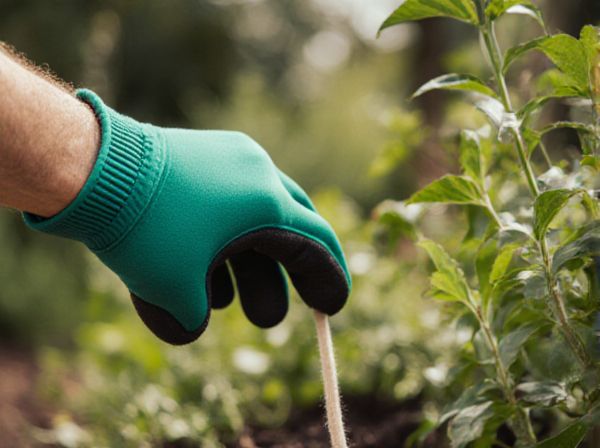
Hand-pulling vs Chemical control Illustration
Hand-pulling offers an eco-friendly and selective method for weed control, effectively removing unwanted plants without harming surrounding vegetation. Chemical control provides a faster solution, especially for large infestations, but requires careful application to prevent environmental damage and resistance development. Choosing between these methods depends on the scale of the infestation, surrounding ecosystem sensitivity, and long-term weed management goals.
Table of Comparison
| Control Method | Effectiveness | Environmental Impact | Cost | Labor Intensity | Speed of Results | Suitability |
|---|---|---|---|---|---|---|
| Hand-Pulling | Moderate to High (depends on weed size and root depth) | Low (eco-friendly, no chemicals) | Low to Moderate (mainly labor costs) | High (requires physical effort and time) | Slow to Moderate (gradual weed reduction) | Small areas, sensitive environments, organic gardens |
| Chemical Control | High (fast and effective for many weed types) | High (potential contamination, affects non-target plants) | Moderate to High (cost of herbicides and application) | Low (less physical effort, quicker application) | Fast (visible results within days) | Large areas, tough weed infestations, non-organic landscaping |
Introduction to Weed Management Methods
Hand-pulling is an effective mechanical weed management method that physically removes weeds, preventing seed dispersal and minimizing soil disturbance, making it suitable for small-scale or sensitive areas. Chemical control utilizes selective herbicides targeting specific weed species, offering rapid and widespread weed suppression but requiring careful application to avoid crop damage and environmental impact. Integrated weed management strategies often combine hand-pulling with chemical treatments to optimize control efficacy and reduce herbicide resistance.
What is Hand-Pulling?
Hand-pulling is a manual weed control method involving physically uprooting weeds by hand or with simple tools to remove the entire root system. This approach is effective for small infestations and prevents the need for chemical herbicides, promoting environmentally friendly weed management. Regular hand-pulling reduces weed seed spread and supports sustainable garden and landscape maintenance.
Overview of Chemical Weed Control
Chemical weed control utilizes herbicides to target and eliminate unwanted vegetation with precision and efficiency. Selecting appropriate herbicides depends on weed species, growth stage, and environmental conditions to maximize efficacy while minimizing collateral damage. Proper application techniques and safety measures ensure optimal weed management and reduce potential risks to non-target plants and ecosystems.
Pros and Cons of Hand-Pulling Weeds
Hand-pulling weeds offers an eco-friendly, chemical-free method that effectively removes roots, reducing weed regrowth and preserving soil health. However, this labor-intensive technique can be time-consuming and less practical for large infestations or deep-rooted species. It poses minimal environmental risk but requires consistent effort to prevent weed resurgence compared to chemical herbicides.
Advantages and Disadvantages of Chemical Control
Chemical control of weeds offers efficient and broad-spectrum action, rapidly targeting large infestations with minimal labor compared to hand-pulling. It allows precise application of herbicides designed for specific weed species, reducing crop competition and improving yield. However, chemical control poses risks such as potential environmental contamination, development of herbicide-resistant weed populations, and negative impacts on non-target plants or beneficial organisms.
Environmental Impact: Hand-Pulling vs Chemicals
Hand-pulling weeds offers an environmentally friendly alternative to chemical herbicides by eliminating the risk of soil and water contamination. Chemical control methods can introduce toxins that disrupt local ecosystems and harm beneficial insects and microorganisms. Manual removal supports sustainable weed management with minimal ecological footprint, making it safer for biodiversity and long-term soil health.
Effectiveness on Different Types of Weeds
Hand-pulling proves highly effective on small patches of broadleaf weeds and shallow-rooted species, providing precise removal without soil disturbance. Chemical control targets a wider range of weed types, including deep-rooted perennials and invasive grasses, with systemic herbicides offering long-lasting suppression. Combining both methods enhances overall effectiveness by addressing diverse weed morphologies and growth cycles.
Cost Comparison: Manual vs Chemical Methods
Hand-pulling weeds involves minimal upfront costs, primarily labor expenses, making it cost-effective for small-scale or low-density infestations but labor-intensive and time-consuming. Chemical control methods require purchasing herbicides, which can be expensive, but they provide quicker and broader weed eradication, reducing labor costs in larger areas. Overall, manual removal suits budget-conscious, small plots, while chemical solutions offer efficiency despite higher material costs for extensive infestations.
Safety Considerations for Gardeners
Hand-pulling weeds offers a safer alternative to chemical control as it eliminates exposure to harmful herbicides, reducing the risk of skin irritation and respiratory issues for gardeners. Protective gloves and proper tools enhance safety during manual removal, minimizing physical strain and potential injuries. Chemical control requires strict adherence to label instructions and protective gear such as gloves, masks, and eye protection to prevent toxic exposure and environmental contamination.
Choosing the Best Method for Your Garden
Hand-pulling weeds offers an eco-friendly and precise solution, ideal for small gardens and preventing chemical runoff. Chemical control provides efficient management for large infestations, utilizing herbicides formulated for specific weed species to minimize damage to desirable plants. Selecting the best method depends on garden size, weed type, and environmental impact considerations to ensure sustainable and effective weed control.
Hand-pulling vs Chemical control Infographic

 gardendif.com
gardendif.com